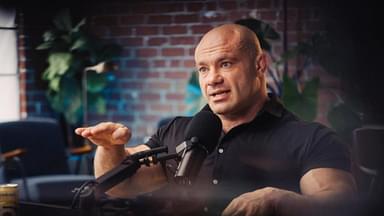Exercise scientist Dr. Mike Israetel is a fitness freak and ensures he hits the gym daily. He exercises his body while understanding what is beneficial to the body and muscles and what is not, all supported by scientific research. While training at the gym and helping people there, the co-founder of Renaissance Periodization also shares knowledge on exercise and fitness through his channel and podcasts.
During a conversation with Chris Williamson on his podcast, Mike disclosed various facts about muscle building. During the interview, Chris asks him a question on motivation and whether it is a scientifically studied thing. Mike responds to the question by mentioning that motivation itself is technically in the construct of adherence.
He continues by pointing out a few factors that lead to motivation: If there’s inspiration and habit, there’s motivation. However, what’s more important than all of this is passion.
“If you have a passion for something, you no longer ask questions of motivation.”
Furthermore, Dr. Mike says that, around motivation, there is a whole psychology. This includes a lot of things that are good for increasing your motivation. A few of them are having good sources of inspiration, setting goals, and what you like at the gym.
Sources of Inspiration: If you surround your social media with a lot of people who look like you and you want to look a little bit like them, they’ve got a lot of positive and encouraging attitudes. This could be a good start, and it might help you start going to the gym.
Set Goals: If you have a goal you want to achieve at the gym, maybe wanting to lift XYZ amount of reps, that’s motivation. If you’re able to tell yourself you want to go to the gym four times a week every day this year, that’s a goal. If you’re goalless and have no reason to go to the gym, you have to give yourself a reason to get up and go to the gym.
Do the kind of stuff at the gym you like: If you’re motivated enough, go to the gym and do your favorite exercise. If you can’t wait to smash some deadlifts, that’s optimal. Go in there and get it done. When we do such things, there are a lot of things coming together in terms of motivation.
However, all this said, Mike further in the podcast says that, if you are going to ask someone how to get motivated to go to the gym, you don’t need to be going to the gym. This means you don’t want it enough.
“When you’re sick and tired of looking and feeling like s**t you’ll show up. I’ll see you there because you’re going to look in the mirror and you’re going to be like f*** that, you’re going to want to be in the gym.”
Israetel further mentions that if you want to make going to the gym a lifestyle, you need to lower your barriers. Your gym should be closer and cheaper, and you should be training with partners, at least in the initial stage. You have to raise the impetus goals inspiration.
For Mike, the gym is his spirit home. Anywhere around the world, the one place he would always want to be is the gym. This is not just the motivation; this is because he wants to do it. He notes that no amount of inspirational movies or Rocky Balboa movies is going to get you to that place.
“One thing is to get yourself into the gym however you see fit consistently. Have a good f****ng time there doing what you love, push yourself, and get those little mini victories.”
However, Mike points out that you shouldn’t push yourself too hard to the point where you start hating the gym. Going to the gym is voluntary, and it’s all for fun; it’s a leisure activity. Therefore, he suggests starting easy and going to the gym twice a week. And progress by doing 30 or 45-minute workouts to get into a habit. Once you’ve been in the habit for a long period, you can then increase the intensity.
“And, you never have to ask yourself the question again of what motivates you to go to the gym because the answer is it’s where I want to be.”
Dr. Mike Israetel reveals the truth about tempo training
Myths about fitness are not new. While we have a lot of exercise myths debunked, Dr. Mike Israetel shares one that states speed employed while performing reps determines growth.
In conversation with his colleague Menno Henselmans, the exercise scientist elaborated on maintaining tempo during exercises. This includes the speed employed while performing each exercise, the amount of stability, holding each rep, and so on. Training tempo has 4 main elements:
- Speed of the eccentric
- Length of degree of pause
- The speed of the concentric
- Degree of squeeze
While answering the question of tempo, he also opined that as long as an individual attains fatigue from any other effective alternative method, tempo does not matter.
Hence, the key to making sure you complete an optimal workout lies in taking it slow and in control. Dr. Israetel wrapped it up by saying that an ideal workout is one where there is total control over movements and good technique.




